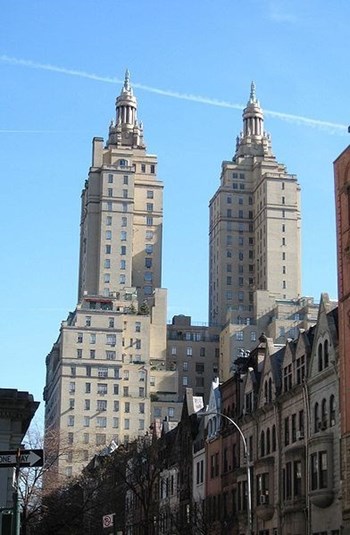
The old adage says that everything old is eventually new again, but if we are talking about a landmarked building in New York City, you may want everything old to stay that way. New York City has over 80 historic districts featuring unique styles of design, exceptional attention to cultural details, and hand-painted or hand-carved architectural embellishments. Of course, a lot of these historic gems are homes to modern people with modern lifestyles and repairing, renovating or changing these buildings in any manner may require special permission.
New York City Landmarks Preservation Commission (LPC) is the city agency responsible for designating and regulating landmarks. The commission has the authority to protect these landmarks—including residential buildings—from any alterations they believe might be harmful to their aesthetic or historic value. A landmark is a building, property, or object that has been designated as such by the LPC for its special character, historical or aesthetic interest or value as part of the development, heritage, or cultural characteristics of the city, state, or nation. (Landmarks are not always buildings. A landmark can be a bridge, a park, a water tower, a pier, a cemetery, a building’s lobby, a sidewalk clock, a fence, or even a tree.) A property or object is eligible for landmark status when at least part of it is at least thirty years old.
Applications and Permits
Tim Fine, executive vice president at Charles H. Greenthal Management Co., welcomes the process of LPC approval on restoration projects. “Management and Landmarks want the same thing; a beautiful building that is well-preserved and retains the style in which it was constructed,” he says.
According to the LPC, every designated structure, whether it is an individual landmark or a building in an historic district, is protected under the Landmarks Law and subject to the same review procedures. The Landmarks Law was enacted in the mid-1960s to protect the city’s architectural, historical and cultural heritage. Any exterior changes, no matter how minor, require the LPC’s permission.
Determining whether your building is already a landmark can be done using an interactive map on the LPC's website, www.nyc.gov/html/lpc. Entering the address will uncover the landmark status of a building as well as other individual, interior and historic landmarks in the surrounding area explains Elisabeth de Bourbon, spokesperson for the LPC.
A phone call to the LPC can elucidate if a permit is even needed for your potential project. For example, repainting previously painted masonry or wood the same color or removing graffiti with approved graffiti removal can be done without a permit. However, repairing, repointing, or resurfacing masonry, replacing brick, cleaning exterior wall surfaces, stripping paint, painting façade surfaces a different color, and other visual changes to the exterior of the building all require a permit. Guidelines also state that work on the interior of a building that will affect a building’s exterior, (such as installing an air conditioning wall unit), must have a permit as well.
Industry experts advise boards and management companies to stick to the regulations of the commission, even if they are more costly than for example, moving forward a different way. The process can be long and can take extra time because of the necessary approval, but the end result will be a historically preserved, fine-free residence.
Take a Number
If a permit is needed, it is time to position your team for maximum efficacy. “An owner can do the application him or herself, but an architect and contractor can help move things along,” says Jeff MacGregor, vice president of PRESERV, an exterior masonry restoration firm in Brooklyn. “Architects and contractors experienced in historic restoration have gone through the process and can reduce the chance that the commission is going to come back with a million questions.”
Currently, the application is a paper process, including documents that must be downloaded and turned in to the LPC. Once the paperwork is in hand, the goal of the LPC is to have the application processed in about ten days, depending on the complexity and duration of the project, says de Bourbon. “The turnaround is relatively quick as long as the person who is submitting the application submits all the materials we need to see in order to make a decision or evaluation about the effect the proposed change will have on the landmark,” she says. Depending on the permit required and the size of the job, a permit application should include blueprints on how the building is going to be altered, photographs of what part of the building is going to be affected, and all the specifications necessary to complete the job.
The commission issues different permits, such as a Certificate of No Effect, which means that your proposed work does not affect the architectural features of a building. According to MacGregor, “This is work that does not affect the outside of the building—including plumbing work and interior work—as long as it’s not a landmarked interior.”
By contrast, a Certificate of Minor Work affects the architectural features of the building, but the intent of the work is to restore and repair those features. A Certificate of Appropriateness means the work being done significantly affects the building’s exterior features. This permit requires a public hearing, appearance in front of the community board, and needs to be approved by the entire commission, a process which can take up to three months. And, says de Bourbon, the LPC issues about 11,000 permits a year and only about five percent of applications fall into this category.
“If you want to put a penthouse on top or remove a significant part of the building, such as its cornice, you need to appear at a public hearing,” says MacGregor. “The commission is reasonable because we think it’s important when you are working on an historic building to be sensitive to its architectural style.”
“The Landmarks are watching out for the building,” says Steven Reif, vice president of Landmark Restoration and Construction Corporation in Long Island City. “If you have the job all spec-ed out, it saves problems with the commission. Then you can take those specs and put out a bid to different experienced contractors.”
Reif explains that he is usually brought on the job after all the paperwork has been completed and he can examine specifications. “By then the color submittals and all the problems are worked out between the owner and the commission,” he says.
Hammer and Tongs
Once permits are granted, the job can begin. The LPC does not have an official inspection team, but believes the public eye helps them to do their job. “We are a complaint driven organization. You have to post our permit in a visible space and it specifies what work is being covered by it. If someone walks by then can easily say, 'this permit is for new windows and it looks like they are stripping the facade'. We do have an enforcement department so someone could call us and we will take a look,” de Bourbon says.
Accessible and user-friendly as they try to be, however, the commission does not take kindly to those who choose to work on landmarked buildings without proper approval. The LPC will first issue a letter to the owner or applicant who has a couple days to respond. Lack of response provokes another letter, after which the LPC moves to violations which can cost up to $5,000 per day if the notification goes unanswered, in the worst case scenario. “We are not here to try to collect money but rather make sure that the projects are in compliance with the Landmark Law,” de Bourbon says.
There’s a reason New York City is often referred to as “Gotham.” We as a community appreciate the sense of history that lingers over our town, and it’s no coincidence that a group like the Landmarks Commission exists to preserve and protect the stately structures that give New York a look like no other city in America. So de Bourbon sums it up, “the goal is to preserve the city's architecture and heritage. The city's buildings are a manifestation of who we are as a city and reflect where we have been and where we are going. That is why it is so important to preserve them.”
Lisa Iannucci is a freelance writer and a frequent contributor to The Cooperator. Editorial Assistant Maggie Puniewska contributed to this article.






Leave a Comment